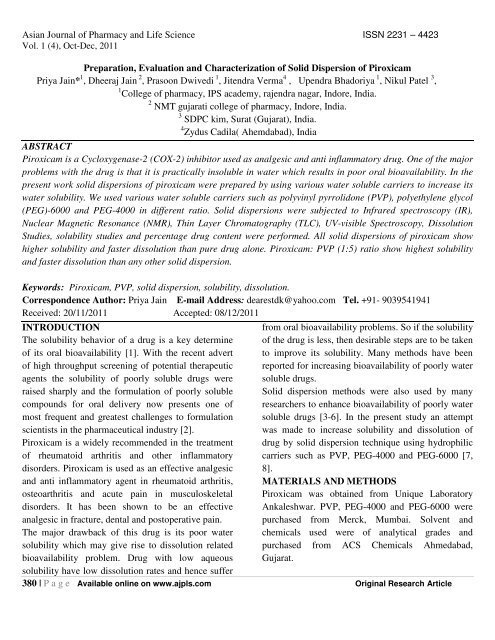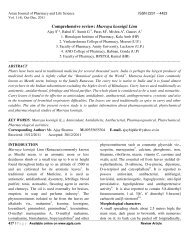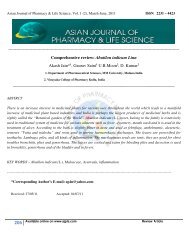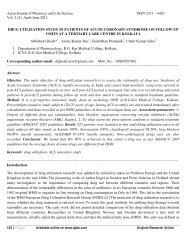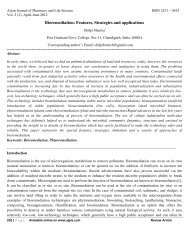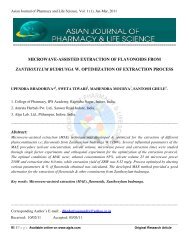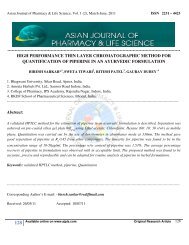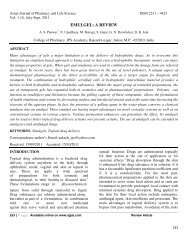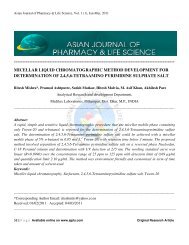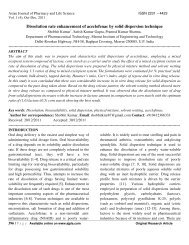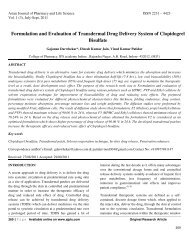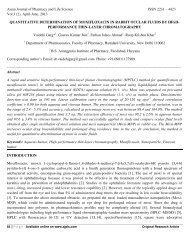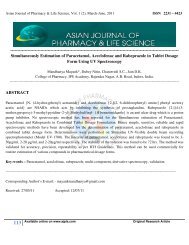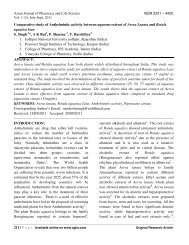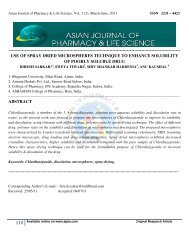Asian Journal of Pharmacy and Life Science ISSN 2231 – 4423 Vol. 1
Asian Journal of Pharmacy and Life Science ISSN 2231 – 4423 Vol. 1
Asian Journal of Pharmacy and Life Science ISSN 2231 – 4423 Vol. 1
Create successful ePaper yourself
Turn your PDF publications into a flip-book with our unique Google optimized e-Paper software.
<strong>Asian</strong> <strong>Journal</strong> <strong>of</strong> <strong>Pharmacy</strong> <strong>and</strong> <strong>Life</strong> <strong>Science</strong> <strong>ISSN</strong> <strong>2231</strong> <strong>–</strong> <strong>4423</strong><br />
<strong>Vol</strong>. 1 (4), Oct-Dec, 2011<br />
Preparation, Evaluation <strong>and</strong> Characterization <strong>of</strong> Solid Dispersion <strong>of</strong> Piroxicam<br />
Priya Jain* 1 , Dheeraj Jain 2 , Prasoon Dwivedi 1 , Jitendra Verma 4 , Upendra Bhadoriya 1 , Nikul Patel 3 ,<br />
1 College <strong>of</strong> pharmacy, IPS academy, rajendra nagar, Indore, India.<br />
2 NMT gujarati college <strong>of</strong> pharmacy, Indore, India.<br />
3 SDPC kim, Surat (Gujarat), India.<br />
4 Zydus Cadila( Ahemdabad), India<br />
ABSTRACT<br />
Piroxicam is a Cycloxygenase-2 (COX-2) inhibitor used as analgesic <strong>and</strong> anti inflammatory drug. One <strong>of</strong> the major<br />
problems with the drug is that it is practically insoluble in water which results in poor oral bioavailability. In the<br />
present work solid dispersions <strong>of</strong> piroxicam were prepared by using various water soluble carriers to increase its<br />
water solubility. We used various water soluble carriers such as polyvinyl pyrrolidone (PVP), polyethylene glycol<br />
(PEG)-6000 <strong>and</strong> PEG-4000 in different ratio. Solid dispersions were subjected to Infrared spectroscopy (IR),<br />
Nuclear Magnetic Resonance (NMR), Thin Layer Chromatography (TLC), UV-visible Spectroscopy, Dissolution<br />
Studies, solubility studies <strong>and</strong> percentage drug content were performed. All solid dispersions <strong>of</strong> piroxicam show<br />
higher solubility <strong>and</strong> faster dissolution than pure drug alone. Piroxicam: PVP (1:5) ratio show highest solubility<br />
<strong>and</strong> faster dissolution than any other solid dispersion.<br />
Keywords: Piroxicam, PVP, solid dispersion, solubility, dissolution.<br />
Correspondence Author: Priya Jain E-mail Address: dearestdk@yahoo.com Tel. +91- 9039541941<br />
Received: 20/11/2011 Accepted: 08/12/2011<br />
INTRODUCTION<br />
from oral bioavailability problems. So if the solubility<br />
The solubility behavior <strong>of</strong> a drug is a key determine <strong>of</strong> the drug is less, then desirable steps are to be taken<br />
<strong>of</strong> its oral bioavailability [1]. With the recent advert to improve its solubility. Many methods have been<br />
<strong>of</strong> high throughput screening <strong>of</strong> potential therapeutic reported for increasing bioavailability <strong>of</strong> poorly water<br />
agents the solubility <strong>of</strong> poorly soluble drugs were soluble drugs.<br />
raised sharply <strong>and</strong> the formulation <strong>of</strong> poorly soluble Solid dispersion methods were also used by many<br />
compounds for oral delivery now presents one <strong>of</strong> researchers to enhance bioavailability <strong>of</strong> poorly water<br />
most frequent <strong>and</strong> greatest challenges to formulation soluble drugs [3-6]. In the present study an attempt<br />
scientists in the pharmaceutical industry [2].<br />
was made to increase solubility <strong>and</strong> dissolution <strong>of</strong><br />
Piroxicam is a widely recommended in the treatment drug by solid dispersion technique using hydrophilic<br />
<strong>of</strong> rheumatoid arthritis <strong>and</strong> other inflammatory carriers such as PVP, PEG-4000 <strong>and</strong> PEG-6000 [7,<br />
disorders. Piroxicam is used as an effective analgesic 8].<br />
<strong>and</strong> anti inflammatory agent in rheumatoid arthritis, MATERIALS AND METHODS<br />
osteoarthritis <strong>and</strong> acute pain in musculoskeletal Piroxicam was obtained from Unique Laboratory<br />
disorders. It has been shown to be an effective Ankaleshwar. PVP, PEG-4000 <strong>and</strong> PEG-6000 were<br />
analgesic in fracture, dental <strong>and</strong> postoperative pain. purchased from Merck, Mumbai. Solvent <strong>and</strong><br />
The major drawback <strong>of</strong> this drug is its poor water chemicals used were <strong>of</strong> analytical grades <strong>and</strong><br />
solubility which may give rise to dissolution related purchased from ACS Chemicals Ahmedabad,<br />
bioavailability problem. Drug with low aqueous<br />
solubility have low dissolution rates <strong>and</strong> hence suffer<br />
Gujarat.<br />
380 | P a g e Available online on www.ajpls.com Original Research Article
<strong>Asian</strong> <strong>Journal</strong> <strong>of</strong> <strong>Pharmacy</strong> <strong>and</strong> <strong>Life</strong> <strong>Science</strong> <strong>ISSN</strong> <strong>2231</strong> <strong>–</strong> <strong>4423</strong><br />
<strong>Vol</strong>. 1 (4), Oct-Dec, 2011<br />
Preparation <strong>of</strong> solid dispersion <strong>of</strong> Piroxicam:<br />
Solid dispersion <strong>of</strong> piroxicam were prepared using<br />
PVP, PEG-4000 <strong>and</strong> PEG-6000 in the ratio <strong>of</strong> 1:1, 1:3<br />
<strong>and</strong> 1:5 individually by solvent evaporation method.<br />
Piroxicam <strong>and</strong> polymers in different ratio were<br />
accurately weighed <strong>and</strong> transferred to a beaker<br />
containing chlor<strong>of</strong>orm. The solvent was evaporated in<br />
vacuum evaporator <strong>and</strong> resulting solid dispersion<br />
stored in desiccators till solid dispersion attain<br />
constant weight. Solidified masses were crushed <strong>and</strong><br />
pulverized <strong>and</strong> passed through mesh number 40.<br />
Evaluation <strong>of</strong> solid dispersion <strong>of</strong> Piroxicam:<br />
Drug carrier interaction study<br />
All prepared solid dispersions were subjected to IR,<br />
TLC <strong>and</strong> NMR study to determine drug carrier<br />
interaction. IR spectra were recorded using FTIR<br />
spectro-photo-meter (8400, schimadzu, Japan), NMR<br />
was carried out at Ch<strong>and</strong>igarh SAIF at 400 MHz.<br />
TLC analysis carried out by E-Merck TLC aluminum<br />
sheets silica gel 60°F 254 (0.2 mm) using solvent<br />
system dichloro-methane: ethanol (20:1), chlor<strong>of</strong>orm:<br />
ethyl-alcohol (10:1) <strong>and</strong> glacial acetic acid :toluene<br />
(5:95) as mobile phase to study any drug carrier<br />
interaction between drug <strong>and</strong> carrier. The Rf values <strong>of</strong><br />
pure drug <strong>and</strong> solid dispersions were calculated.<br />
Percentage drug content study<br />
Drug content was determined by dissolving 0.001-1%<br />
w/v solution <strong>of</strong> solid dispersion <strong>of</strong> drug in 0.01M<br />
methanolic hydrochloric acid kept in ultra sonicator<br />
for 20 min. The solution then filtered with whatman<br />
filter paper no. 41. The absorbance was measured at<br />
242 nm using double beam UV spectrophotometer<br />
(2450, schimadzu, Japan).<br />
Solubility study<br />
Solubility study was performed according to method<br />
reported by Higuchi <strong>and</strong> Connors [9] . Excess <strong>of</strong> solid<br />
dispersion were added to 25 ml distilled water <strong>and</strong><br />
taken in stoppered conical flask. Mixture was shaken<br />
for 24 hours in rotary flask shaker. Shaking is<br />
performed till equilibrium achieved <strong>and</strong> 2 ml aliquots<br />
were withdrawn at 1 hour interval <strong>and</strong> filtered<br />
through Whatman filter paper no. 41. Filtrate<br />
obtained was analyzed by UV spectrophotometer at<br />
242 nm.<br />
Dissolution study:<br />
Solid dispersion equivalent to 15 mg <strong>of</strong> piroxicam<br />
was filled in hard gelatin capsules by h<strong>and</strong> filling<br />
method. Dissolution study was carried out using USP<br />
XXI six dissolution test apparatus (Lab India)<br />
employing USP type I apparatus. Dissolution study<br />
was carried out using 900 ml <strong>of</strong> 0.1N HCl <strong>and</strong><br />
rotating basket at 100 revolutions per minute.<br />
Withdraw a 10 ml sample <strong>of</strong> medium at time interval<br />
<strong>of</strong> 5, 10, 15, 20, 25, 30, 45 <strong>and</strong> 60 minutes. The<br />
volume <strong>of</strong> dissolution medium adjusted to 900 ml by<br />
replacing each 10 ml aliquot with 10 ml fresh 0.1 N<br />
HCl. Concentration <strong>of</strong> piroxicam samples were<br />
determined by measuring absorbance at 242 nm.<br />
Dissolution efficiency is defined as the area under<br />
dissolution curve up to the time expressed as<br />
percentage <strong>of</strong> the area <strong>of</strong> rectangle described by 100<br />
% dissolution in the same time.<br />
AUC <strong>of</strong> dissolution curve at 90min<br />
DE90 =<br />
AUC <strong>of</strong> rectangle at time 90min<br />
t90 <strong>–</strong> time required for 90% dissolution <strong>of</strong> drug<br />
RESULTS AND DISCUSSION<br />
Preparation <strong>of</strong> solid dispersion <strong>of</strong> Piroxicam:<br />
Solid dispersion prepared using PEG-4000 <strong>and</strong> PEG-<br />
6000, were relatively easy to prepare as compared to<br />
solid dispersion prepared using PVP. Various<br />
effective formulation <strong>of</strong> solid dispersion <strong>of</strong> piroxicam<br />
is shown in table 1.<br />
Evaluation <strong>of</strong> solid dispersion <strong>of</strong> Piroxicam<br />
Drug: Carrier interaction study:<br />
IR-Study:<br />
IR spectra <strong>of</strong> solid dispersion <strong>of</strong> piroxicam show all<br />
IR peaks <strong>of</strong> drug <strong>and</strong> carrier. No other peaks were<br />
observed which indicates that there was no evidence<br />
<strong>of</strong> interactions between drug <strong>and</strong> carriers. The major<br />
381 | P a g e Available online on www.ajpls.com Original Research Article
<strong>Asian</strong> <strong>Journal</strong> <strong>of</strong> <strong>Pharmacy</strong> <strong>and</strong> <strong>Life</strong> <strong>Science</strong> <strong>ISSN</strong> <strong>2231</strong> <strong>–</strong> <strong>4423</strong><br />
<strong>Vol</strong>. 1 (4), Oct-Dec, 2011<br />
IR peaks observed in solid dispersion are shown in<br />
table 2.<br />
H 1 NMR Study:<br />
NMR spectra <strong>of</strong> solid dispersion <strong>of</strong> piroxicam show<br />
all NMR peaks <strong>of</strong> drug <strong>and</strong> carrier <strong>and</strong> no other peaks<br />
were observed which indicates that there was no<br />
evidence <strong>of</strong> interactions between drug <strong>and</strong> carriers.<br />
The major IR peaks observed in solid dispersion are<br />
shown in table 3.<br />
TLC Studies:<br />
TLC studies shows following Rf values in different<br />
mobile phase<br />
a) MDC (Dichloromethane): Ethanol (19:1)<br />
0.50-0.56<br />
b) Chlor<strong>of</strong>orm: Ethyl alcohol (9:1)<br />
0.65-0.70<br />
c) Toluene: acetic acid (95:5)<br />
0.73-0.76<br />
The results <strong>of</strong> TLC analysis are shown in table 4.<br />
Percentage drug content study:<br />
Percentage drug content <strong>of</strong> solid dispersion was found<br />
to be in range <strong>of</strong> (96.60±1.30) (98.50±0.95) (Table-<br />
5). It shows uniform distribution <strong>of</strong> drug in all solid<br />
dispersion.<br />
Solubility study:<br />
All the solid dispersion showed enhancement in<br />
solubility as compared to pure drug alone. The drug:<br />
carrier ratio (1:5) showed higher solubility as<br />
compared to 1:1 <strong>and</strong> 1:3 in all solid dispersion.<br />
Solubility enhancement is observed in following<br />
order.<br />
PEG6000 > PEG4000>PVP<br />
Dissolution study:<br />
All solid dispersion prepared by solvent evaporation<br />
showed faster dissolution as compared to pure drug<br />
alone. Dissolution rate <strong>of</strong> pure drug is less because <strong>of</strong><br />
hydrophobic nature <strong>of</strong> drug.<br />
CONCLUSION<br />
Piroxicam being oxicam derivatives has less<br />
solubility in water so we had prepared various solid<br />
dispersion <strong>of</strong> piroxicam with various carriers like<br />
PVP, PEG-4000, PEG-6000, in ratio 1:1, 1:3, 1:5<br />
respectively to enhance the solubility as compared to<br />
piroxicam alone. Amongst all the solid dispersion 1:5<br />
type <strong>of</strong> solid dispersion shows highest solubility.<br />
Various other analytical studies <strong>of</strong> solid dispersion<br />
are also performed i.e. IR studies, NMR studies, TLC<br />
studies in support <strong>of</strong> research work showing no drug<br />
carrier interaction<br />
Table-1: Various effective formulations <strong>of</strong> solid dispersion <strong>of</strong> piroxicam<br />
Code no. Piroxicam PVP PEG-6000 PEG-4000<br />
P1<br />
1<br />
-<br />
-<br />
-<br />
P2<br />
1<br />
-<br />
-<br />
-<br />
P3<br />
1<br />
5<br />
-<br />
-<br />
P4<br />
1<br />
10<br />
-<br />
-<br />
P5<br />
1<br />
-<br />
1<br />
-<br />
P6<br />
1<br />
-<br />
5<br />
-<br />
P7<br />
1<br />
-<br />
10<br />
-<br />
P8<br />
1<br />
-<br />
-<br />
1<br />
P9<br />
1<br />
-<br />
-<br />
5<br />
P10<br />
1<br />
-<br />
-<br />
10<br />
382 | P a g e Available online on www.ajpls.com Original Research Article
<strong>Asian</strong> <strong>Journal</strong> <strong>of</strong> <strong>Pharmacy</strong> <strong>and</strong> <strong>Life</strong> <strong>Science</strong> <strong>ISSN</strong> <strong>2231</strong> <strong>–</strong> <strong>4423</strong><br />
<strong>Vol</strong>. 1 (4), Oct-Dec, 2011<br />
Table-2: The major IR peaks observed in solid dispersion <strong>of</strong> Piroxicam.<br />
S. IR peaks<br />
No. (in cm -1 )<br />
1. 3250<br />
2. 1640-1680 -CONH, Amide<br />
group <strong>of</strong> drug<br />
3. 1290-1330 -CN stretching <strong>of</strong><br />
drug<br />
4. 1040-1060 > S=O stretching <strong>of</strong><br />
drug<br />
Functional Groups Piroxicam Piroxicam Piroxicam Piroxicam<br />
-NH,-OH Stretching + + + +<br />
+ + + +<br />
+ + + +<br />
+ + + +<br />
Table-3: The major NMR Peaks <strong>of</strong> solid dispersion <strong>of</strong> Piroxicam.<br />
S. No. NMR b<strong>and</strong> PEG-4000 PEG-6000 PVP<br />
1. 290ppm + + +<br />
2. 9.2ppm + + +<br />
3. 13.1ppm + + +<br />
Table-4: TLC analysis <strong>of</strong> solid dispersion <strong>of</strong> Piroxicam.<br />
Code no. Rf value from<br />
Rf value from<br />
MDC : Ethanol<br />
CHCl3 : Ethanol<br />
P1<br />
0.56<br />
0.70<br />
P2<br />
0.52<br />
0.68<br />
P3<br />
0.54<br />
0.68<br />
P4<br />
0.55<br />
0.69<br />
P5<br />
0.52<br />
0.67<br />
P6<br />
0.53<br />
0.68<br />
P7<br />
0.54<br />
0.68<br />
P8<br />
0.50<br />
0.65<br />
P9<br />
0.51<br />
0.66<br />
P10<br />
0.51<br />
0.67<br />
Rf value from<br />
Toluene:Acetic acid<br />
0.76<br />
0.74<br />
0.72<br />
0.75<br />
0.74<br />
0.74<br />
0.75<br />
0.73<br />
0.74<br />
0.74<br />
383 | P a g e Available online on www.ajpls.com Original Research Article
<strong>Asian</strong> <strong>Journal</strong> <strong>of</strong> <strong>Pharmacy</strong> <strong>and</strong> <strong>Life</strong> <strong>Science</strong> <strong>ISSN</strong> <strong>2231</strong> <strong>–</strong> <strong>4423</strong><br />
<strong>Vol</strong>. 1 (4), Oct-Dec, 2011<br />
Table-5 Solubility <strong>and</strong> % drug content <strong>of</strong> solid dispersion <strong>of</strong> Piroxicam.<br />
Code no. System Solubility t90 % drug content<br />
± (S.D.)<br />
P1<br />
P2<br />
P3<br />
P4<br />
P5<br />
P6<br />
P7<br />
P8<br />
P9<br />
P10<br />
Piroxicam<br />
Piroxicam;pvp(1:1)<br />
Piroxicam:pvp(1:3)<br />
Piroxicam:pvp(1:5)<br />
Piroxicam:PEG6000 (1:1)<br />
Piroxicam:PEG6000(1:3)<br />
Piroxicam:PEG6000(1:5)<br />
Piroxicam:PEG4000(1:1)<br />
Piroxican:PEG4000(1:3)<br />
Piroxicam:PEG4000(1:5)<br />
REFERENCES<br />
1. L<strong>of</strong>tsson T., Brewster M., Masson M. Role <strong>of</strong><br />
cyclodextrin in improving oral drug delivery.<br />
Am. J. Drug Deliv. 2004; 2: 1-9.<br />
2. Mahaparale P. R., Gudsoorkar V. R., Gajeli S.<br />
B., Kuchekar B. S. Studies on solid<br />
dispersions <strong>of</strong> Meloxicam. Indian J. Pharm.<br />
Edu. Res. 2006; 40: 241-245.<br />
3. Nalluri B. N., Chowdary K. P. R., Murthy K.<br />
V. R., Hayman A. R., Becket G.<br />
Physicochemical characterization <strong>and</strong><br />
dissolution properties <strong>of</strong> nimesulidecyclodextrin<br />
binary systems. Pharm. Sci.<br />
Tech. 2003; 4: E2.<br />
4. Naidu N. B., Chowdary K. P., Murthy K. V.,<br />
Satyanarayana V., Hayman A. R., Becket G.<br />
Physicochemical characterization <strong>and</strong><br />
dissolution properties <strong>of</strong> meloxicamcyclodextrin<br />
binary system. J. Pharm.<br />
Biomed. Anal. 2004; 35: 75.<br />
0.00285<br />
0.01238<br />
0.02530<br />
0.03520<br />
0.00650<br />
0.00790<br />
0.01640<br />
0.00590<br />
0.00750<br />
0.01450<br />
>90<br />
>90<br />
>72.5<br />
>55.7<br />
>90<br />
>85<br />
>76<br />
>90<br />
>90<br />
>86<br />
96.58±1.30<br />
97.58±1.52<br />
97.93±.91<br />
96.60±1.27<br />
97.62±1.48<br />
98.00±.95<br />
96.62±1.33<br />
97.60±1.56<br />
98.07±.93<br />
5. Struengmann A., Freudensprung B., Klokkers<br />
K. Pharmaceutical compositions <strong>of</strong><br />
meloxicam with improved solubility <strong>and</strong><br />
bioavailability. US patent 6284269. 2001.<br />
6. El-Shaboury M. H. Physical properties <strong>and</strong><br />
dissolution pr<strong>of</strong>iles <strong>of</strong> tablets directly<br />
compressed with β-cyclodextrin. Int. J. Pharm.<br />
1990; 63: 100.<br />
7. Narang A., Srivastava A. Evaluation <strong>of</strong> solid<br />
dispersion <strong>of</strong> cl<strong>of</strong>azimine. Drug Dev. Ind.<br />
Pharm. 2002; 28: 1001.<br />
8. Fern<strong>and</strong>ez M., Rodriguez I. C., Margarit M.<br />
V., Cerezo A. Characterization <strong>of</strong> solid<br />
dispersions <strong>of</strong> piroxicam/polyethylene glycol<br />
4000. Int. J. Pharm. 1992; 84: 197-202.<br />
9. Higuchi T., Connors K. A. Phase solubility<br />
techniques. Adv. Anal. Chem. Instr. 1965; 4:<br />
117.<br />
384 | P a g e Available online on www.ajpls.com Original Research Article


